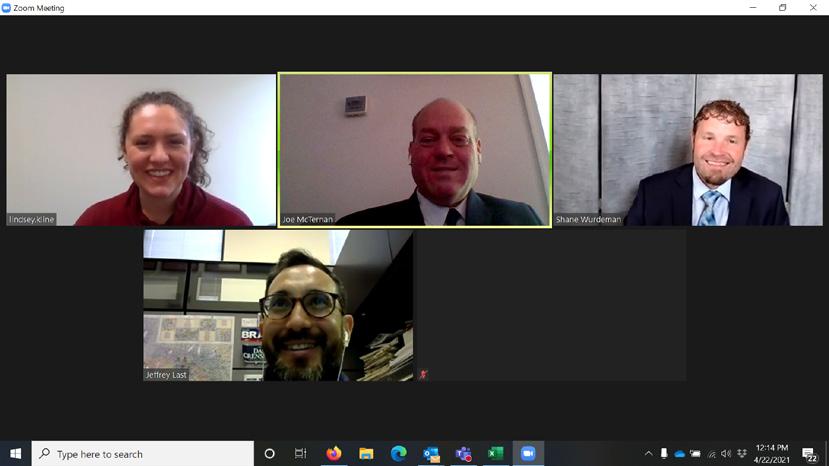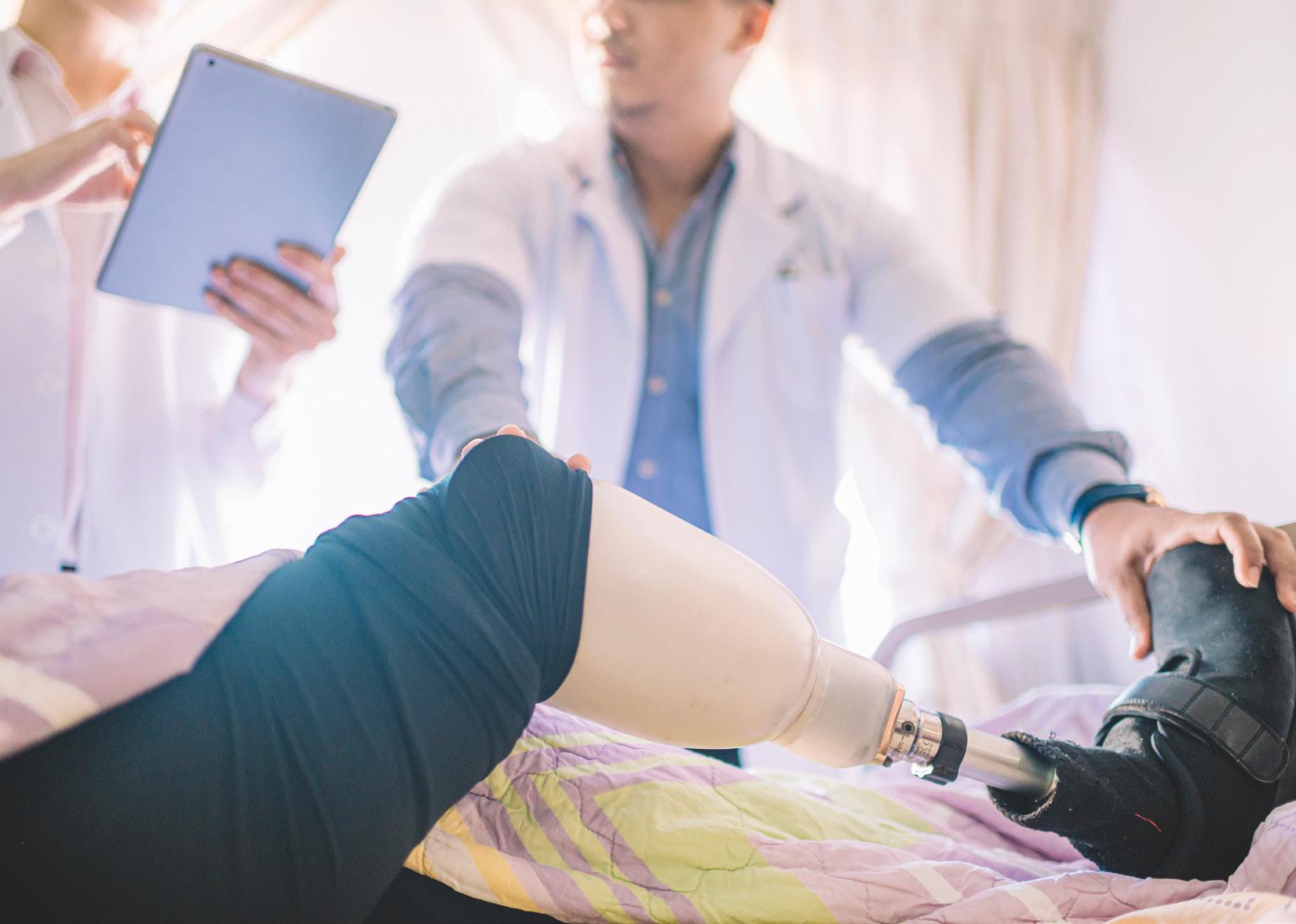
39 minute read
Reimbursement Page
from May 2021 O&P Almanac
by AOPA
Gazing Into the Crystal Ball
What does a postpandemic environment look like for O&P?
Editor’s Note—Readers of
Reimbursement Page are eligible to earn two CE credits. After reading this column, simply scan the QR code or use the link on page 15 to take the Reimbursement Page quiz. Receive a score of at least 80 percent, and AOPA will transmit the information to the certifying boards.
EARN 2 QUIZ ME!
BUSINESS CE CREDITS
P.15
IF YOU ARE LIKE me, when you first heard the words “coronavirus” and “COVID-19,” you thought they would cause a short-term inconvenience, and that life would return to normal after a few weeks.
More than one year later, the world has changed forever. The COVID-19 public health emergency (PHE) has claimed millions of lives, and each step forward in battling the virus seems to be met with new setbacks, including variants of the virus and surges in infection rates.
While the COVID-19 PHE is far from over, the introduction of effective vaccines and continued efforts to reduce the spread of disease have resulted in a little twinkle of light at the end of a long, dark tunnel. This month’s Reimbursement Page takes a look into the future to predict five things that may impact your O&P business in a postpandemic environment. 1 TPE Will Return CMS acted quickly last spring to ensure that Medicare and Medicaid beneficiaries would continue to have access to effective and appropriate clinical care. Shortly after the PHE declaration, CMS announced significant relaxation of policy requirements to provide flexibility to providers and allow them to focus their efforts on caring for patients rather than chasing documentation. One of these flexibilities was an announcement of the suspension of audits for claims with dates of service during the COVID-19 PHE.
This announcement resulted in the suspension of Medicare Target, Probe, and Educate (TPE) audits. The TPE program was implemented in 2018 and transformed the way many Medicare audits were handled. TPE audits are focused in scope and usually examine up to 20 claims at a time on a prepayment basis; they consist of up to three rounds of audit activity with individual, providerbased education after each TPE round.
The intent of this process is to address incorrect billing practices and eliminate errors through education. Once a provider shows sufficient improvement in their billing practices, they may be moved out of the TPE process and exempt from future TPE audits for a defined period, usually at least one year. The TPE program has been successful and is very popular with providers, who enjoy fewer audits and increased education.
Since TPE audits are always performed on a prepayment basis, they cannot be performed during the PHE. As a result, the TPE program has been formally suspended for the duration of

the COVID-19 PHE. Since the TPE program has proven to be very successful and is popular among Medicare contractors and providers, it is reasonable to assume that once the COVID-19 PHE is declared over, CMS will instruct its contractors to reinstitute the TPE program.
2Telehealth Is
Here To Stay
If you want to identify one positive development that came about because of the COVID-19 PHE, it would be the emergence of telehealth as a viable and efficient method to deliver high-quality, effective healthcare. While telehealth is not a new concept, Medicare rules have been historically restrictive when it comes to reimbursement for telehealth services—so much so that many providers have been discouraged from considering telehealth as a viable pathway to treat Medicare patients.
The COVID-19 PHE forced Medicare and other payors to revisit policies regarding telehealth services in the interest of patient health and safety. As a result of the PHE, telehealth restrictions have been significantly relaxed to allow providers and patients to communicate effectively without having to be in the same location. Historically, telehealth rules have been fairly restrictive to ensure proper security as well as compliance with the Health Insurance Portability and Accountability Act; however, technology has advanced to the point where telehealth services can be coordinated through multiple delivery models that allow for delivery of effective healthcare in a secure setting.
The successful use of telehealth services during the COVID-19 PHE will most likely result in significant changes to the prepandemic restrictions on the use of telehealth as a viable and accepted method to deliver effective healthcare.
3RAC Audits Will Focus
on Claims Made During the PHE
CMS has stated that claims with dates of service during the PHE are not subject to audit currently—but there has been no discussion about whether those claims will be subject to future audits, including those performed by recovery audit contractors (RACs). CMS has provided significant flexibility regarding coverage policy requirements to ensure that Medicare patients have continued to have access to needed medical care during the PHE.
Despite the relaxation of some of the requirements, it remains important to properly document general medical necessity to support claims that are paid by Medicare. RAC contractors are compensated based on their successful identification of Medicare overpayments and are paid a percentage of the money that is recouped based on their audits. RACs rely on identifying “low-hanging fruit” to maximize their profitability.
It is a reasonable assumption that RAC contractors will be very interested in reviewing claims with dates of service during the PHE. While traditional policy requirements that were relaxed because of the COVID-19 PHE will not be subject to RAC review, the RACs may be able to identify scenarios where policy requirements that remained in effect during the PHE were not met, resulting in an overpayment determination by the RAC.
4The Need for O&P
Services May Increase
The COVID-19 PHE has resulted in the loss of millions of lives across the globe. What has yet to be realized is how the COVID-19 PHE has impacted the health of individuals for reasons not directly related to the coronavirus pandemic.
Throughout the COVID-19 PHE, the provision of general healthcare has been affected, especially in rural and traditionally underserved areas. Whether caused by access issues or reluctance to seek care due to concerns about potential exposure, some individuals may have received fewer healthcare services than they would have outside of a global pandemic. The impact of this reduction in overall healthcare services may be more prevalent for patients who were already at risk for limb loss or limb impairment— and may ultimately lead to higher rates of amputation and increased episodes of conditions such as stroke and orthopedic conditions that may increase the need for orthotic intervention.
Since the COVID-19 PHE remains an active pandemic, it is difficult to quantify the impact it has had on the future need for O&P care—but it is a reasonable expectation that there will be some impact on at-risk patients.
5Healthcare Integration
Will Continue
The integration of the delivery of healthcare services is not a new trend. The impact of a significant global pandemic will most likely increase efforts of health systems to pursue integrated healthcare delivery as a strategy to reduce costs and increase efficiency.
O&P has traditionally been considered a niche market when compared to the much larger healthcare universe; however, as major health systems look for new and innovative models to streamline their businesses, O&P may garner more attention. The integration of O&P business has seen a significant increase in recent years as the lines between patient care, distribution, and manufacturing become a little more blurred, but the impact of the COVID-19 PHE may bring more external resources into the mix as larger health systems look to increase their footprint beyond their traditional lines of business.
What Does the Future Hold?
None of the five predictions listed above are guaranteed, and the changing nature of the PHE may further impact any or all of these forecasts.
Only one thing is certain: The impact of the COVID-19 PHE on healthcare worldwide will be significant and will result in permanent changes to healthcare delivery models.
Joseph McTernan is director of reimbursement services at AOPA. Reach him at jmcternan@AOPAnet.org. Take advantage of the opportunity to earn two CE credits today! Take the quiz by scanning the QR code or visit bit.ly/OPalmanacQuiz.
Earn CE credits accepted by certifying boards:
This Just In
Advocating for Patients During the Policy Forum— and Beyond

Practitioners, patients, and business owners convened remotely to push for the Medicare O&P Patient-Centered Care Act, with ongoing advocacy needed

ONE HUNDRED AND FIFTY O&P stakeholders met online to take part in the 2021 AOPA Policy Forum and focus on one “ask”: for legislators to support and sponsor the Medicare O&P Patient-Centered Care Act. O&P business owners, clinicians, patients, and related advocates participated in virtual meetings with nearly 150 members of Congress and their staffs April 20-22 and 27-29. During those meetings, stakeholders explained the need for the legislation—HR 1990 in the House of Representatives and awaiting a bill number in the Senate—before asking lawmakers for their support.
Policy Forum participants were optimistic after the meetings, reporting that many legislators and staffers agreed to consider sponsoring the legislation. However, new guidelines from the Committee on Rules in the House of Representatives recommend that new bills seek 100-120 co-sponsors before they are brought before committee. AOPA is asking that all O&P stakeholders—whether they were able to attend the Policy Forum or not—continue to contact members of Congress to ask them to co-sponsor HR 1990 and the Senate bill.
For O&P professionals considering contacting their legislators, it’s important to understand the four key provisions that comprise the Medicare O&P Patient-Centered Care Act: differentiating O&P from durable medical equipment, restoring the original congressional definition of “minimal self-adjustment,” prohibiting drop shipping of devices that are not truly off-the-shelf, and exempting certified and/or licensed orthotists and prosthetists from competitive bidding.
HR 1990
It also will be helpful during future legislative meetings to “educate legislators about the clinical services you provide and the patients you care for,” said Ashlie White, AOPA’s director of strategic alliances. She encouraged Policy Forum attendees to emphasize that “the Medicare O&P benefit should not be treated like DME and supplies in the statute and regulations.”
HR 1990 was introduced to the House of Representatives in the 117th Congress on March 17 by Reps. Mike Thompson (D-California), Brett Guthrie (R-Kentucky), GK Butterfield (D-North Carolina), and GT Thompson (R-Pennsylvania). It is expected to be introduced in the Senate immediately following the Memorial Day Recess, with Sens. Mark Warner (D-Virginia), Steve Daines (R-Montana), Tammy Duckworth (D-Illinois), John Cornyn (R-Texas), and Chuck Grassley (R-Iowa) expected to introduce the bill at that time.

Tips for Virtual Legislative Meetings
During the opening session of the Policy Forum, experienced O&P advocates offered 10 tips for facilitating successful virtual meetings with members of Congress. These suggestions, shared by a group of Minnesota stakeholders who frequently advocate together, serve as helpful reminders for the O&P community as it continues to push for the Medicare O&P PatientCentered Care Act in upcoming meetings with legislators. 1. Be prepared. Dress for success, even in the virtual world, said Teri
Kuffel, JD, vice president of Arise
Orthotics & Prosthetics and AOPA vice president. She suggested calling or emailing the day before to confirm your appointment. Prior to the meeting, make sure your computer is set up with optimal video and audio capabilities, then choose an appropriate background for a Zoom call, “with no distractions such as bright lights, loud sounds, or busy backgrounds.” AOPA is asking that all O&P stakeholders—whether they were able to attend the Policy Forum or not— continue to contact members of Congress to ask them to co-sponsor HR 1990 and the Senate bill.

Eve Lee , MBA, CAE, AOPA executive director Joe McTernan, AOPA director of coding and reimbursement services, education, and programming Ashlie White , MA, AOPA director of strategic alliances
2. Do your homework. Review materials in advance and become “the expert in the room,” recommended
Kuffel. For meetings centering on the current Medicare O&P Patient-
Centered Care Act, make sure you understand the four main provisions and are able to explain why they facilitate optimal O&P patient care. It’s also important to explain your issue in terms lawmakers will understand, without using
O&P acronyms. “Realize that these decision makers really need to be educated; we need to explain to them what the device is, the functionality of the device, and the difference between an orthotic and prosthetic,” said Aaron Holm, executive director of Wiggle Your
Toes and manager of consumer marketing and engagement for
Ottobock. 3. Select your spokespersons. Ideally, at least three O&P stakeholders will be involved in a legislative visit: a practitioner, a patient, and a policy/businessperson/student, said Kuffel. “Patients help educate and personalize the O&P issues; practitioners explain how access to care and devices can be challenged; and policy/business/students advocate” and clarify the impact of O&P intervention, she said.
Teri Kuffel, JD, AOPA vice president






Peter Thomas , NAAOP general counsel
“I can’t stress how important it is to bring someone with limb loss with you,” added Rob Rieckenberg, a Wiggle Your Toes board member and above-knee amputee since 2005.
He recommends “showing your hardware” on screen—a more challenging feat virtually than in person, but helpful nonetheless, he said. Regardless of how many advocates are on hand, it’s important to plan ahead of time which individuals will take the lead on discussing the different points you plan to address. 4. Be brief and stay focused. Have a short outline with you and stick to it, said Kuffel. Start with an ice breaker or hometown small talk; know your legislator’s party affiliation; find out if they are on a committee that is important to
O&P; know your legislator’s recent voting record; and use specific bill numbers and share the names of the sponsors, said Kuffel. This background information can help you navigate the conversation and focus on the important issues. 5. Personalize your issues. Tell a few stories about caring for your patients, and consider sharing how an unfair denial, audit, or
appeal has had a negative impact on patients, suggested Kuffel, to demonstrate some of the challenges of providing access to O&P care and devices. For example, Rieckenberg said he often shares his experiences navigating insurance coverage and caps on prosthetic devices, and how he has had to fight for coverage as a person with limb loss. Stories such as these may resonate with legislators who have family members with limb loss or difference. 6. Be positive and react honestly.
Try to focus on the positive aspects of the O&P world because “our patients have remarkable stories and need our help,” said Kuffel.
“Don’t be afraid to address some of the negatives, but try to sandwich them between the positives.” If you don’t know the answer to a question, be honest and say, “I’m not sure, but I can find out and get back to you.” And keep in mind that your legislator wants your vote and works as your advocate, said Kuffel. 7. Be friendly with the legislative staff. Many legislative meetings are handled by staff members, rather than the legislators themselves. Find out with whom you are meeting ahead of time, said Kuffel.
It’s likely the staff member assigned to your call has a healthcare focus, so “try to establish a relationship with that staffer, and follow up afterward to keep the connection going,” said Kuffel. “Be comfortable, be excited, and be relatable.” “Don’t get discouraged if you’re meeting with a staffer,” added
Holm. “Realize you are building a connection. In a couple of years, that staffer could be working for another legislator, or could become a legislator themselves.” 8. Close the deal, and remember the ask. Be very clear regarding why you are participating in the meeting: Ask them to co-sponsor the bill; ask them to vote on the bill; ask for their support on future
O&P-related issues; and ask them to take a photo, even if virtual, said Kuffel. In addition, “don’t hesitate to ask them if there’s anything they need from you,” added Holm, such as follow-up information or supporting documents that will help them support the issue at hand.
9. Leave behind materials. For virtual meetings, you will have to email supporting documents that you would normally bring with you to in-person meetings, so be sure you have appropriate email contact information, suggested Kuffel.
For legislative meetings centering

Teri Kuffel, JD, Rob Rieckenberg, and other O&P advocates met with the staff of Sen. Tina Smith (D, Minnesota) during the AOPA Policy Forum.
on the Medicare O&P Patient-
Centered Care Act, leave-behind materials summarizing the legislation can be found on AOPA’s website at www.aopanet.org/ legislative-regulatory/2021virtual-policy-forum. 10. Say “thank you.” “Common courtesies go a long way,” said Kuffel.
“Remember to say ‘please’ and
‘thank you’” during the meeting, then follow up with email or written correspondence. Then, “stay in touch offseason” by touching base with your legislators at local parades and events, and proffer personalized invitations to legislators to tour your patientcare office. “Give them a reason to fly home to visit your facility,” said
Holm. “They love to see individuals in their home states and post about it on their social media.”

As the O&P community continues to push for the Medicare O&P PatientCentered Care Act to improve access to quality orthotic and prosthetic services and devices for patients, more stakeholders should consider reaching out to legislators to engage in virtual meetings. After the pandemic, AOPA expects to return to the Hill in person—while continuing to facilitate some meetings virtually, as this method of communicating has emerged as an effective form of advocacy. With both in-person and virtual meetings, “your impact is immediate,” said White.
“Remember that we are all here to educate and advocate with purpose,” said Kuffel, “to provide access for our patients to orthotic and prosthetic care and devices.”



BRONZE

Teri Kuffel, JD; Charles Kuffel, CPO; Eve Lee, MBA, CAE; and others met with a representative from Minnesota during the Policy Forum.
THANK YOU
TO OUR 2021 SPONSORS

SUPPORTER

Our voices are louder together.

Composite Triple Action® AFO


The Root
of Pain


What prosthetists should know about postamputation pain—and the new studies that could impact future treatments

By CHRISTINE UMBRELL
NEED TO KNOW

• O&P professionals frequently encounter patients dealing with different types of pain, including residual limb pain, phantom limb pain, amputated-side-knee and sound-knee pain, and low-back pain. • Prosthetists play an important role in pain management by providing well-fitting sockets, optimal alignment of prostheses, and appropriate componentry selection. • Phantom limb pain appears to be closely related to residual limb pain, and is highly variable. Prosthetists can help educate patients about nonpharmacological strategies to minimize this type of pain, including shrinker socks, activity pacing, and mirror therapy. • Some lower-limb prosthesis users experience a significant
“collision,” or impact, on their intact limb during gait, causing knee pain; solutions that focus on softening the landing or reducing the load could minimize pain. • Determining underlying causes of low-back pain and related issues may require referral to other healthcare providers, such as physical therapists, psychologists, or physicians specializing in pain management. • Researchers are currently studying phantom limb pain and neuromodulation; radiofrequency ablation for neuromas; and other novel techniques to minimize pain in the limb loss population. PEOPLE with limb loss experience many challenges beyond amputation—including management of “a number of different pain types,” says Phil Stevens, MEd, CPO, director of the Department of Clinical and Scientific Affairs at Hanger Clinic and adjunct faculty at Concordia St. Paul. “There is phantom pain, or pain in a body segment that is no longer present; residual limb pain; and pain secondary to overuse symptoms, either in the torso, upper back and shoulders, or within the sound-side extremity.”
As part of the multidisciplinary care team, prosthetists offer a unique perspective to their patient’s long-term pain management. By recognizing the different types of pain and discomfort in patients, offering suggestions to help patients minimize or manage their pain, referring patients to other healthcare professionals when appropriate, and staying current on the latest research and new pain protocols under investigation, prosthetists can play a role in their patients’ overall rehabilitation.
Pain Manifestation
Different types of amputations can lead to varying types of pain. Available evidence suggests that “persistent postoperative limb pain is 1.5 times more likely with upper-limb amputation,” says Stevens. Very few individuals with upper-limb amputation describe their situation as ‘pain-free.’” Upper-limb patients also are more likely to experience severe pain, at a greater frequency. “Roughly two-thirds of those with upper-limb amputation describe their pain as ‘moderate’ to ‘severe,’ compared to less than a third of those with lower-limb amputation,” says Stevens. “Almost all individuals with upper-limb amputation report pain on ‘most days’ or ‘every day,’ compared to about one-third of those with lower-limb amputation.”
Individuals with lower-limb loss may face different challenges. They experience low-back pain at up to four times the rate seen in the general population, according to Samantha Stauffer, MSOP, CPO, a clinician at Independence Prosthetics-Orthotics and a doctoral student in biomechanics and movement science at the Delaware Limb Loss Studies Lab at the University of Delaware. “On top of that, more than 50 percent experience phantom limb pain and/or residual limb pain,” she says. Chronic pain is associated with mood instability, limits in physical function, and reduced employment, says Stauffer.
Andreas Kannenberg, MD (GER), PhD, executive medical director for Ottobock Healthcare LP in Austin, Texas, led a team that collected data on sound-knee pain, residual knee pain, and low-back pain in individuals with unilateral transtibial amputation and K3 mobility. His team completed a cross-sectional study that compared the effect of different prosthetic feet on these types of pain with concurrent and recalled ratings.
Of the 57 patients surveyed, only 7 percent did not report pain in any of three locations, according to Kannenberg. Fifty-three percent reported sound-knee pain, 44 percent reported residual knee pain, 61 percent reported low-back pain, and 28 percent reported pain in all three body regions of 3 or greater out of 10. “These numbers confirm that pain is a huge health issue in the population of individuals with lower-limb amputation,” Kannenberg says. He points to a wide array of contributing factors.
Sound-knee and low-back pain may be caused by the reduced push-off of passive prosthetic feet, resulting in higher loads to the sound limb and knee as well as asymmetric activation of pelvic and trunk muscles that, over time, results in back pain, says Kannenberg. Amputated-side knee pain in transtibial amputees may be caused by increased mechanical stress to the knee due to the
Phil Stevens, MEd, CPO lack of adaptation of feet with rigid ankle attachments to uneven walking surfaces, he adds.

In addition, some amputees may suffer from local residual limb pain due to hypersensitivity, scar tissue, or even keloids, neuromas, ulcers, bone spurs at the amputation cut, conditions like ossifying myositis, and poor socket fit that stresses the soft tissue of the residual limb, explains Kannenberg. On the sound-limb side, “joint pain … is usually caused by increased mechanical stress as the sound limb takes over more weight-bearing than the amputated limb,” he says. “Reduced push-off of passive prosthetic feet is one contributor to that. If patients use walking aids, such as crutches, canes, or walkers, they may also suffer from overuse pain in joints of the upper limb, especially the shoulder, elbow, and wrist.”
Andreas Kannenberg, MD (GER), PhD
Phantom and Residual Limb Pain
Phantom limb pain, while complicated, is the most common pain experience for the limb loss population, according to Stevens. Phantom pain appears to be closely related to residual limb pain. “In other words, those individuals that report phantom limb pain are much more likely to report pain in their residual limb,” he says. “Those patients who deny phantom pain are much less likely to report residual limb pain. That trend suggests that some individuals may have trouble differentiating their pain experiences, or that one pain type triggers the other.”
Tonya Rich, PhD, OTR/L, recently studied 50 veterans with limb loss and found that they had difficulty differentiating between residual limb pain and phantom pain. In some cases, what they called phantom pain was located where their residual limb met their prosthesis, “so it was actually residual limb pain,” says Rich, an occupational therapist and researcher at the Minneapolis Adaptive Design Engineering (MADE) Program at the Minneapolis VA and an assistant professor in the Department of Rehabilitation Medicine at the University of Minnesota. “We identified that there are education needs as far as how veterans learn to differentiate that pain.”
The biggest takeaway from the survey, according to Rich, “is that phantom limb pain is highly variable.” While some participants experienced very intense phantom pain just a few times a year, others reported experiencing discomfort in the “phantom” area several times a day. “There are very few commonalities between patients,” says Rich.
Rich also found that many patients were unaware of strategies that may reduce phantom pain, without the use of medications or over-the-counter drugs. “We found that 54 percent of veterans had one or fewer nonpharmacological techniques they had tried for this type of pain, in our sample,” says Rich. “This means that there are a lot of common ways to manage this pain” that had not been communicated to patients.
She encourages prosthetists to ensure their patients are familiar with “very basic nonpharmacological interventions.” For example, “Wearing a shrinker sock is reported to be beneficial,” she says. Activity pacing can ensure patients aren’t overdoing activities at certain times and are instead breaking up tasks and considering the “wear schedule” of their prosthesis.
Alleviating Knee Pain and Osteoarthritis
Several factors affect the mechanical effects of walking with a prosthesis, including foot shape, foot size, fitness, and step length. “There’s a connection between mechanical aspects [of movement] and the experience of pain,” says Peter Adamczyk, PhD, an assistant professor in the Department of Mechanical Engineering at the University of Wisconsin—Madison. A biomechanist, Adamczyk studies ways to reduce the “collision” that takes place during gait—the impact felt by prosthesis wearers when they
Peter Adamczyk, land on their feet during each
PhD step of walking. He is particularly concerned with the impact on the knee for prosthetic users and the possibility of osteoarthritis in the intact leg. “Push-off and collision with the ground redirect center-of-mass velocity,” he explains. “Collision is large on the intact limb.”
Adamczyk has hypothesized that prosthesis wearers experiencing knee pain could benefit from three separate solutions to reduce the impact of walking with a prosthesis. First, taking shorter steps may reduce collision, he says; while this can burn more energy, it also reduces loading.
Second, stiffness and length of the prosthetic foot’s structural keel may correlate to reduced collisions: A stiffer or longer foot “supports body weight further out onto the toe,” he says. Therefore, a prosthesis wearer could potentially soften their landing, reduce the load, and minimize pain by switching to a prosthetic foot that is one or two sizes longer than their natural side foot, he suggests, although he points out this idea has not yet been researched. Third, “to some extent, there’s evidence supporting the notion that powered prostheses” can help reduce the load, thereby reducing the long-term risk of osteoarthritis and pain, says Adamczyk. More research is needed on each of these three suggestions, he emphasizes, to test if they actually do help with the collision phase of walking and potentially reduce pain.
Tonya Rich, PhD, OTR/L
Psychosocial Factors Linked to Back Pain

At the Delaware Limb Loss Studies Lab, Samantha Stauffer, MSOP, CPO, and her team looked at self-reported outcome measures of individuals with a major lower-limb amputation and long-standing low-back pain.
“Individuals who remained unemployed more than a year after their amputation had lower prosthesis use, increased perceived disability, increased anxiety, and poorer coping with their pain, even though there were no differences in pain intensity when compared to those who were employed,” Stauffer says. “What that means is that asking about Samantha Stauffer, MSOP, CPO pain intensity alone might not provide enough information about prognosis. Emerging pain research suggests that addressing psychological factors may be critical.”
Several treatments exist for low-back pain, depending on the etiology, according to Stauffer. “Determining underlying causes may require a referral to another member of the patient’s healthcare team, such as a physical therapist, psychologist, or physician specializing in pain management,” she says. “Strengthening and mobility exercises have been shown to be effective at reducing low-back pain in the general population. For patients with chronic pain, pain education and cognitive behavioral therapy … may be needed to improve function and reduce disability.
“Biomechanics may contribute to the increased prevalence of low-back pain after amputation, but biomechanics are unlikely to tell the whole story,” adds Stauffer. “Just as we, as practitioners, assess physical presentations of our patients, we should screen for psychosocial factors that may be contributing to their pain.” Prosthetists increase their value to the healthcare team and can positively impact patients’ outcomes when they identify the need for and facilitate timely referrals for factors outside their scope of practice, according to Stauffer.
“We should always acknowledge the patient’s pain, as all pain is real even if we can’t identify the source, and refer when our efforts, such as prosthetic adjustments, do not resolve their symptoms,” says Stauffer. “It is also vital to recognize when pain is resulting in significant mental stress, which may manifest as major depression or suicidal ideation, and facilitate immediate referral.”
Rich also advocates mirror therapy for phantom pain—a technique that was underreported in the veteran survey. “Mirror therapy is where you actually use a mirror alongside your contralateral limb, so you have this mirrored impression as if you have both limbs, and you do a series of exercises as you’re watching in the mirror to give the brain the feedback that the limb is there,” she explains. “One theory is that the body keeps sending all these pain signals because it’s not getting that feedback. For some people with limb loss, mirror therapy can be highly effective.”
Rich recently launched a new study—a two-year VA-funded project in partnership with the University of Minnesota, Center for Magnetic Resonance Research—focusing on phantom limb pain and neuromodulation. “We are studying both the maps of the brain (functional MRI or fMRI task) and how the brain circuits are active at rest,” she explains. “Together, this information will give us a window into the brain. If we can identify, potentially, a brain circuit that’s contributing to pain, we may be able to design interventions to either up-regulate that brain circuit or down-regulate that brain circuit. For example, if we find there is a circuit that’s overactive in people who have more pain, we can design interventions to inhibit that brain circuit.”
Cole Cheney, MD, a graduating resident at the University of Utah School Hospitals and founder of Cheney and Associates Medical Consulting, also is studying this type of pain. He is part of a team that recently conducted a systematic review of percutaneous nonsurgical interventions for phantom and/or residual limb pain. In addition, he is leading a grant-funded trial evaluating radiofrequency ablation for neuromas: a nonsurgical, minimally invasive procedure that, traditionally, uses heat to reduce or stop the transmission of pain; radiofrequency waves ablate, or “burn,” the nerve that is causing the pain, theoretically eliminating the transmission of pain signals to the brain.
Cheney and his team use MRI to identify the neuroma in the distal residual limb of study participants, before testing whether an anesthetic injection temporarily eases the participant’s pain. If that works, then they proceed to the ablation technique, where they use a probe heated to 60 degrees Celsius near the neuroma for three minutes; this destroys the distal end of the nerve while preserving muscle and skin. “We’ve seen good outcomes” in terms of pain reduction, opioid use reduction, and increased activity among study participants, says Cheney. He intends to close enrollment for this study in the next few months, then analyze and publish the findings.

Cheney has plans to test other techniques for reducing pain, including peripheral nerve stimulation and dorsal root ganglion stimulation/ spinal cord stimulation—structures in the spinal cord that plays a key role in the development and management of chronic neuropathic pain.
He will be joining Northwestern’s Pain Department as a fellow in July, where he will expand his research to contralateral limb interventions. “One study showed that trigger-point injections on the sound side [among individuals with limb loss] showed improvements in pain on the affected side,” similar to how mirror therapy can aid patients with phantom limb pain, according to Cheney. “We will look at lidocaine injections and eventually peripheral nerve stimulation” on patients’ intact limbs to see if they help ease limb loss pain on the other side, he says.

Cole Cheney, MD Prosthetic Interventions
Of course, there are some techniques today that prosthetists can try to help alleviate some of the pain their patients may be experiencing. For example, a new, well-fitting socket can relieve residual limb pain and/or sound-limb and low-back pain caused by compensating for a poor socket fit and prosthesis control.
In addition, prosthesis alignment is an often-overlooked contributor to pain. “For example, aligning a prosthesis ‘too safe’ makes it more difficult and requires more and asymmetric muscle activation/power to initiate swing, resulting in overuse pain over time,” Kannenberg says. “Aligning a prosthesis ‘too functional’—or, in other words, too unstable—requires asymmetric, untimely, and unphysiological muscle activation/power to stabilize the prosthesis and prevent it from collapsing, which may also result in overuse pain over time,” he says.
When it comes to component selection, “prosthetists should aim at reducing or even preventing compensatory mechanisms that usually require asymmetric, untimely, and unphysiological muscle activation/ power, reducing or eliminating the use of additional walking aids, and selecting components that are most appropriate for the activities that their patients do on a regular basis,” adds Kannenberg. For example, patients who negotiate heavily uneven terrain and steeper slopes on a regular basis may benefit from a hydraulic or microprocessor-controlled ankle with sufficient range of motion, rather than a foot with a rigid ankle attachment, according to Kannenberg. “If a patient is a fast walker who walks distances of three miles or 7,500 steps or more on a typical day, then prosthetists may want to consider a powered foot to help alleviate pain.”
Kannenberg points to the study of 57 subjects with unilateral transtibial amputation and K3 mobility. “We found that patients reported significant and clinically meaningful reductions in sound-knee, amputated-side knee, and low-back pain when using a powered prosthetic foot (BiOM or Empower) as compared to their recalled pain when using their previous passive prosthetic feet, even when the recalled pain ratings were adjusted for recall bias,” he says. Significantly more patients reported no sound-knee pain, no low-back pain, and no pain in all three body regions surveyed with use of powered, rather than passive, feet. “Significantly fewer patients reported pain of 3 or greater out of 10 in the sound knee, amputated-side knee, lower back, and all three body regions with the powered as compared to the passive feet,” says Kannenberg. The manuscript of this study is currently under review at the Journal of Rehabilitation and Assistive Technologies Engineering.
Improving Mobility and Quality of Life
As prosthetists do their part to help patients identify their pain and minimize their discomfort, individuals with limb loss will be increasingly likely to use their prostheses and participate in activities.
“What I found, anecdotally, is that when people have experienced a lot of phantom limb pain, their inactivity skyrockets, so they’re not putting on their prosthesis; they’re not going out in public,” says Rich. “If we can develop effective techniques around pain management, I would hope to see an increase in activity, an increase in functional use of prostheses, and more participation in daily life.”
Christine Umbrell is a contributing writer to O&P Almanac. Reach her at cumbrell@contentcommunicators.com.
Reconnect, Recharge, and Refresh Your Knowledge
2021
SAVE THE 2021 DATES
Join your colleagues in Boston—or virtually—and immerse yourself in the latest O&P education at the 2021 AOPA National Assembly

IT’S TIME! After 18 months of limiting social interactions to prevent further spread of the coronavirus, the nation is opening back up—and AOPA is ready! The 2021 AOPA National Assembly will be held in-person in Boston, September 9-11, and will be followed by virtual presentations one week later, September 16-18, in a hybrid format designed to be accessible to all O&P stakeholders.
This year’s Assembly will offer many opportunities to connect with other O&P professionals, catch up on the latest O&P research, and learn easy-to-implement clinical and business strategies. There will be dozens of educational sessions to choose from, but here’s a sneak peek at four sessions you should plan to attend at this year’s premier O&P event.
Prosthetics: Old School Vs. High-Tech
You won’t want to miss this debate on prosthetic fabrication, scanning, and socket design, which will address the benefits of both conventional care and the cutting edge in O&P. This dynamic session, called “Human Vs. Machine, Fred Flintstone Vs. George Jetson, Plaster Stains Vs. Carpal Tunnel Syndrome: Who Will Win— The ‘Tried and True’ or the Newest Tech?” will be presented by Jim Young, CP, LP, owner of Amputee Prosthetic Clinic in Georgia, and Jeff Erenstone, CPO, owner of Mountain Orthotic & Prosthetic Services in Lake Placid, New York. “Much like words in our language evolve, so do the processes and materials that we use to create things,” says Young.
Both Young and Erenstone use digital technology to some extent in their practices. But while Young says he has “yet to find a digital scanner that will capture what I believe to be the most crucial proximal area when creating a transfemoral prosthetic socket,” Erenstone is an advocate of scanning and 3D-printing technologies.
“I depend a lot on my digits to provide me with feedback by palpating boney prominences, determining tissue consistency, and identifying pressure-sensitive areas,” explains Young. He wears a transfemoral socket and has experienced first-hand “the difference between ‘close’ and ‘correct.’”
Erenstone, on the other hand, describes 3D printing as an exciting new technology that will have “a huge part to play in the future of fabrication in O&P.”
But both presenters see value in both traditional and newer O&P processes and procedures, and they plan to offer “a light-hearted discussion” about the pros and cons of each. “For example,” explains Young, “if I am using plaster, then heat and humidity may influence set time. Conversely, Jeff may be having computer software complications, [unreliable] internet service, or a computer crash,” he says. “So, old school verses new school … each will have fans and detractors.”
The presenters will come to the session dressed in costume to debate “in character,” Erenstone adds: “The ‘futurist’ will have a scripted debate with the ‘old-timey craftsman.’ We want to make it fun while imparting knowledge in a self-deprecating way.”
“Information is critical for making informed decisions. It is important to talk about the pros and cons of different approaches and be familiar with as many styles and alternatives to do our jobs as possible,” says Young. “Although the tools, materials, and processes may change, the most important aspect—the goal of optimizing patient outcomes—does not.”

Orthotics: The Latest in Ankle Bracing
Stay on the cutting edge of orthotics by attending this symposium on updates in ankle-foot orthosis (AFO) technology. Andreas Kannenberg, MD (GER), PhD, executive medical director for Ottobock Healthcare LP, and Gerald Stark, PhD, MSEM, CPO, LPO, senior clinical specialist at Ottobock, will lead the session “Advances in AFO Technology,” which will focus on the recently introduced “next-generation” orthotic ankle designs that promise to provide more dynamic movement and rollover.
“Orthotists commonly employ componentry that either locks, blocks, or resists movement,” explains Stark. While providing a great deal of safety, these types of devices sacrifice possible dynamic movement during gait, he says. “New componentry of the ankle and knee promises to provide dynamic assist as well as modular adjustment that can provide increased movement during gait.” This new componentry requires a change in clinical approach to enhance and increase freedom of movement, according to Stark.
Speakers will examine the integration of these designs within orthotic clinical practice. Speakers from research and manufacturing will present and discuss the concepts of evaluation, selection, adjustment, and subsequent outcomes during this cross-platform roundtable discussion. “The areas that will be addressed are the collective similarities and differences of dynamic orthotic ankle designs as well as perspectives in how they are implemented,” Stark says.
Presenters will share relevant research on patient selection and the efficacy of this componentry. “Clinical optimization strategies will also be shown, demonstrating how the devices are tuned and applied with other orthotic devices,” Stark notes. Session leaders will ask questions and “gather contributions from attendees as to the effectiveness of these alternative components,” he adds. Clinicians interested in the benefits of more dynamic movement for orthotic wearers should mark their calendars for this session.
Pedorthics: Diabetic Foot-Care Strategies

Whether you’re an orthotist or a pedorthist, this symposium—“Management of the Diabetic Foot”—will cover many aspects of foot care and boost your clinical knowledge. “Diabetes numbers just keep increasing—not only in the aging population, but in all age groups,” says Dennis Janisse, CPed, founder of National Pedorthic Services Inc.
Approximately 30.3 million U.S. residents have diabetes—23.1 million diagnosed and 7.2 million undiagnosed, according to the Centers for Disease Control and Prevention; that equates to 9.4 percent of the U.S. population. It’s also estimated that 84.1 million U.S. adults have prediabetes. Given these statistics, “orthotic, prosthetic, and pedorthic practitioners will be seeing more diabetes patients with varying degrees of issues,” says Janisse.
Janisse will be leading this symposium in Boston, accompanied by Erick Janisse, CO, corporate trainer at DJO Global, and Brian Lane, CPed, director of education for Dr. Comfort. They will share their expertise on a wide range of topics of critical importance to clinicians who treat patients with diabetes. Participants will learn about the prevalence of the disease and how to manage some of its most complicated conditions and deformities. “Owners, practitioners, administrators, billing personnel—everyone on the patientcare team needs this information to care for their diabetes patients appropriately, effectively, and efficiently,” says Janisse.
The presenters will drill down to discuss several topics in detail, including the impact of diabetes on the foot; diabetes and obesity in the United States; pedorthic management of the partial foot; the Charcot foot; and the “total package” surrounding the diabetic shoe. In addition, attendees will learn how to navigate the Therapeutic Shoe for Persons With Diabetes (TSPD) benefit, and “how to make the TSPD benefit work,” Janisse says. Participants will return to their offices with tangible solutions to assist them in treating their diabetic patients.
Best Business Practices:
Documentation Tips for Advanced Devices
Learn tips for ensuring your patients have access to the most appropriate devices in “Justifying Medical Necessity and Documentation.” Participants in this symposium will hear how medical necessity for advanced prosthetic and orthotic devices should be documented in the physician’s and CPO’s records, says Kannenberg. He will lead this session alongside Harry Schwartz, MD, from MossRehab Einstein in Philadelphia, Danielle Melton, MD, from Memorial Hermann Houston, and Linda Collins, MS, from Össur.
The language in the policies stresses that the patient must meet certain criteria to be eligible for advanced technology. “However, from a physician’s perspective, it’s all about identifying safety and/or mobility needs of the patient that are unmet by the current prosthesis/orthosis,” explains Kannenberg. “If a patient meets the policy criteria but doesn’t have least one unmet need, then he or she is basically eligible for advanced technology but doesn’t demonstrate the medical necessity—need—for it.”
Documentation should demonstrate the medical necessity for an advanced device, according to Kannenberg. “For instance, if a patient does all the activities listed in microprocessorcontrolled knee (MPK) policies with a non-microprocessor-controlled knee without any problems, what would be the justification to fit an MPK that is [much more] expensive? Take-home message: A patient who is doing great doesn’t qualify for an upgrade.”
Creating the record is “like walking a fine line,” Kannenberg adds: “You have to make sure that the patient meets all the criteria in the policy to demonstrate eligibility for advanced technology but still needs to demonstrate at least one unmet safety and/ or mobility need,” he explains. “So, the patient must be doing good enough with the current prosthesis or orthosis to meet the policy eligibility criteria, but not as good as he or she wants or needs to be.” Kannenberg and his co-presenters will discuss appropriate documentation in detail—to ensure coverage of the most appropriate technology for O&P patients.
2021
SAVE THE 2021 DATES
2021 Assembly Registration Opens Soon
Visit www.aopanet.org for details on this year’s AOPA National Assembly. Registration will open in early June. Choose from two registration options: in-person with online access or virtual only. Both will have access to the online content for 90 days post-Assembly. Email assembly@ aopanet.org with questions.

